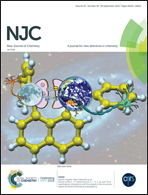Synthesis and crystal structures of a copper(ii) dinuclear complex and zinc(ii) coordination polymers as materials for efficient oxidative desulfurization of dibenzothiophene†
Abstract
The synthesis, structure and physical properties of a dinuclear copper(II) complex [Cu2(BAc)4(QX)2], and 2D zinc(II) coordination polymers, [Zn(TDPA)2(TMPy)2]n (where HBAc = 4-hydroxyl benzoic acid; QX = quinoxaline; HTDPA = 3,3-thiodipropionic acid; TMPy = 4,4-trimethylenedipyridine) are presented. The complexes were characterised by elemental analysis, FT-IR, electronic spectroscopy and thermogravimetric analysis. The structures of all the complexes were determined by single crystal X-ray diffraction studies. The geometry around the Cu(II) of [Cu2(BAc)4(QX)2] is slightly distorted square pyramidal, with four oxygen atoms of the carboxylate occupying the trans orientation and one quinoxaline molecule occupying the axial position. [Zn(TDPA)2(TMPy)2]n coordination polymers are linked by two (μ-N)2 coordination TMPy and two (μ-O)2 (halves) from (TDPA)−. [Zn(TDPA)2(TMPy)2]n stacks in layers with disordered water molecules in the voids. This work further investigated [Cu2(BAc)4(QX)2] catalysed oxidation of dibenzothiophene (DBT) followed by the adsorption of the resulting dibenzothiophene sulfoxide (DBTO) over [Zn(TDPA)2(TMPy)2]n. The theoretical strength of adsorption is in the order of DBTO-[Zn(TDPA)2(TMPy)2]n (binding energy of −53.10 kJ mol−1) > DBT-[Zn(TDPA)2(TMPy)2]n (binding energy of −38.53 kJ mol−1) suggesting that the presence of oxygen influences the adsorption process. The use of [Cu2(BAc)4(QX)2] and [Zn(TDPA)2(TMPy)2]n in model fuel resulted in 97% oxidation of DBT with an adsorption capacity of 35.5 mg g−1, respectively.



 Please wait while we load your content...
Please wait while we load your content...